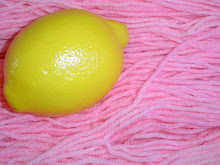Excellent Question
I’ll be blocking my Extra Credit shawl today, but I really don’t have anything to show you right now. Fortunately, KayT of the comments asked a great question about the Yarn Over edging of Ondine!
Like many, many shawl patterns, Ondine uses Yarn Overs (YO) as increases. This results in a row of YO’s at the edges of the shawl, which looks great and blends well with a lace pattern when there is lace in the middle of the shawl (Ondine has stockinette stitch, the only lace is the crocheted lace edge). Since there is no other lace in the shawl, I didn’t feel like I was necessarily married to YO’s for my shaping increases. Then, as I was reading through the notes on other people’s projects, I noticed one person mentioned that the YO’s at the edge made weaving in the ends from the stripes difficult. That helped me make up my mind. I was going to do this differently.
For my Ondine, I decided to go ahead and work the YO’s, but I would close them on the following row. I could have worked Make One’s as my increases, those are closed when you make them; but they also tend to tighten the area they’re in. With several rows of plain stockinette between them, it isn’t noticeable, but all of them in a single area (the edge) would have made it tighter than I wanted it. By using YO’s, the edge didn’t get too tight, and then I could just twist them on the next row. The YO’s at the beginning of Right Side Rows and the end of Wrong Side Rows were wrapped the usual way, and then knit (or purled) through the back loops on subsequent rows. The YO’s at the end of RS rows and beginning of WS rows were wrapped reverse (back to front) and then knit (or purled) the regular way through the front loops. This gave me the shaping the pattern called for, but made it easier to weave in the ends because I didn’t have a row of holes at the edge. This is the only change I made to the pattern, which is beautifully written and very easy to follow.
I’ve added these notes to my project page on Ravelry as well so they’ll be easy to find (and I’ll be able to remember if I do this pattern again).
Like many, many shawl patterns, Ondine uses Yarn Overs (YO) as increases. This results in a row of YO’s at the edges of the shawl, which looks great and blends well with a lace pattern when there is lace in the middle of the shawl (Ondine has stockinette stitch, the only lace is the crocheted lace edge). Since there is no other lace in the shawl, I didn’t feel like I was necessarily married to YO’s for my shaping increases. Then, as I was reading through the notes on other people’s projects, I noticed one person mentioned that the YO’s at the edge made weaving in the ends from the stripes difficult. That helped me make up my mind. I was going to do this differently.
For my Ondine, I decided to go ahead and work the YO’s, but I would close them on the following row. I could have worked Make One’s as my increases, those are closed when you make them; but they also tend to tighten the area they’re in. With several rows of plain stockinette between them, it isn’t noticeable, but all of them in a single area (the edge) would have made it tighter than I wanted it. By using YO’s, the edge didn’t get too tight, and then I could just twist them on the next row. The YO’s at the beginning of Right Side Rows and the end of Wrong Side Rows were wrapped the usual way, and then knit (or purled) through the back loops on subsequent rows. The YO’s at the end of RS rows and beginning of WS rows were wrapped reverse (back to front) and then knit (or purled) the regular way through the front loops. This gave me the shaping the pattern called for, but made it easier to weave in the ends because I didn’t have a row of holes at the edge. This is the only change I made to the pattern, which is beautifully written and very easy to follow.
I’ve added these notes to my project page on Ravelry as well so they’ll be easy to find (and I’ll be able to remember if I do this pattern again).
Labels: Loopy Academy, Tutorials










0 Comments:
Post a Comment
<< Home